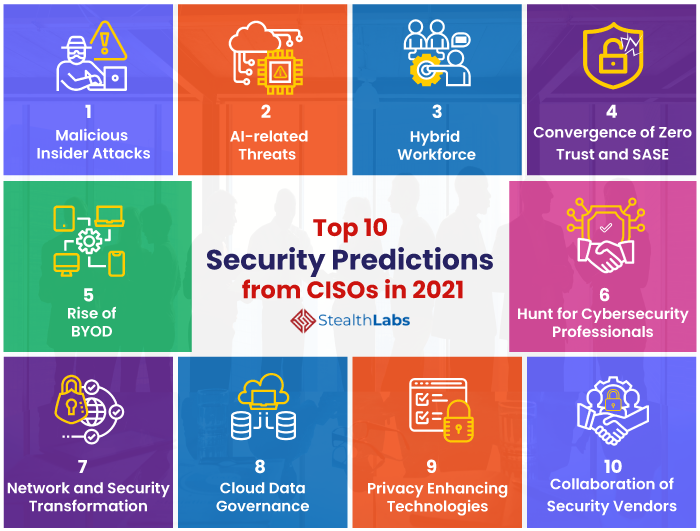Take a closer look at 7 Cybersecurity Predictions for 2025 to prepare for emerging threats.
Take a closer look at 7 Cybersecurity Predictions for 2025 to prepare for emerging threats.
Blog Article
The Following Frontier: Insightful Cybersecurity Predictions for the Coming Year
As we approach the brand-new year, the cybersecurity landscape is on the edge of significant change. Key aspects such as the assimilation of sophisticated AI technologies, the unpreventable increase of innovative ransomware, and the tightening up of data personal privacy regulations are forming the future of digital protection. Moreover, the continuous prevalence of remote job continues to subject new susceptabilities that organizations need to browse. Understanding these characteristics is essential for expecting the difficulties in advance and strategically strengthening defenses, yet the effects of these changes stay to be totally explored.
Increase of AI in Cybersecurity
In the quickly advancing landscape of cybersecurity, the integration of expert system (AI) is emerging as an essential pressure in improving hazard detection and response abilities. AI innovations, such as artificial intelligence formulas and deep understanding versions, are being increasingly deployed to assess vast amounts of information and recognize patterns a measure of security threats. cyber resilience. This makes it possible for companies to proactively resolve vulnerabilities before they can be exploited
The rise of AI in cybersecurity is specifically substantial in its capacity to automate regular tasks, allowing human analysts to concentrate on even more complicated protection concerns. By leveraging AI, cybersecurity teams can decrease action times and enhance the accuracy of danger evaluations. Additionally, AI systems can adjust and learn from new risks, continuously fine-tuning their discovery mechanisms to stay in advance of harmful actors.
As cyber dangers become more innovative, the need for innovative options will drive more investment in AI innovations. This trend will likely result in the advancement of improved protection devices that integrate predictive analytics and real-time tracking, ultimately fortifying business defenses. The change towards AI-powered cybersecurity services stands for not just a technological shift yet a fundamental adjustment in how organizations approach their safety methods.
Boost in Ransomware Attacks
Ransomware strikes have actually become a widespread risk in the cybersecurity landscape, targeting organizations of all dimensions and throughout different fields. As we advance right into the coming year, it is expected that these strikes will not only boost in regularity but likewise in sophistication. Cybercriminals are leveraging sophisticated methods, including making use of artificial intelligence and artificial intelligence, to bypass standard security steps and make use of susceptabilities within systems.
The rise of ransomware attacks can be credited to several elements, consisting of the surge of remote job and the expanding dependence on electronic services. Organizations are typically not really prepared for the advancing hazard landscape, leaving critical facilities susceptible to breaches. The financial implications of ransomware are incredible, with firms encountering substantial ransom demands and possible long-term functional disturbances.
Moreover, the trend of double extortion-- where assailants not only secure data but also threaten to leakage delicate details-- has actually gotten traction, even more persuading victims to adhere to demands. Therefore, organizations have to focus on robust cybersecurity steps, including normal back-ups, worker training, and occurrence reaction planning, to minimize the threats connected with ransomware. Failure to do so can bring about ravaging consequences in the year ahead.
Advancement of Data Personal Privacy Laws
The landscape of data personal privacy guidelines is undergoing substantial improvement as governments and companies reply to the boosting problems bordering personal information protection. Recently, the application of comprehensive structures, such as the General Data Defense Policy (GDPR) in Europe and the California Customer Privacy Act (CCPA) in the United States, has established a criterion for stricter personal privacy legislations. These policies highlight look at this website customers' rights to regulate their data, mandating transparency and liability from organizations that accumulate and process personal details.

In addition, companies will certainly require to boost their conformity techniques, investing in sophisticated innovations and training to secure sensitive information. The development of data privacy regulations will not only influence just how organizations run yet likewise shape consumer assumptions, fostering a society of trust fund and protection in the electronic landscape.
Growth of Remote Work Susceptabilities
As companies proceed to accept remote work, susceptabilities in cybersecurity have actually significantly involved the forefront. The shift to adaptable job plans has exposed critical voids in protection procedures, particularly as staff members accessibility sensitive data from diverse places and devices. This decentralized workplace creates an increased assault surface for cybercriminals, that make use of unsecured Wi-Fi networks and individual gadgets to infiltrate business systems.

To mitigate these vulnerabilities, companies must focus on extensive cybersecurity training and carry out robust safety and security structures that encompass remote job circumstances. This includes multi-factor verification, normal system updates, and the establishment of clear procedures for data gain access to and sharing. By resolving these vulnerabilities head-on, business can promote a more secure remote work atmosphere while keeping functional strength when faced with evolving cyber hazards.
Improvements in Danger Discovery Technologies


Positive risk detection has actually ended up being a keystone of modern cybersecurity strategies, reflecting the immediate need to neutralize progressively sophisticated cyber risks. As companies face an advancing landscape of susceptabilities, advancements in hazard detection innovations are crucial in mitigating risks and enhancing security poses.
One notable fad is the integration of expert system and artificial intelligence right into threat discovery systems. These technologies allow the evaluation of vast quantities of information in real time, enabling the recognition of anomalies and potentially destructive activities that may avert traditional safety and security actions. Additionally, behavioral analytics are being applied to develop baselines for regular customer activity, making it much easier to detect discrepancies a measure of a violation.
Moreover, the increase of automated danger knowledge sharing systems facilitates collective defense efforts throughout sectors. This real-time exchange of details enhances situational awareness and speeds up action times to arising hazards.
As companies remain to purchase these advanced technologies, the efficiency of cyber defense systems will dramatically improve, encouraging safety and security teams to stay one step ahead of cybercriminals. Ultimately, these developments will play an important role in shaping the future landscape of cybersecurity.
Conclusion
In summary, the approaching year is expected to witness transformative developments in cybersecurity, driven by the combination of AI technologies and a notable increase in why not check here ransomware strikes. As information personal privacy guidelines end up being much more strict, organizations will require to improve compliance techniques. The ongoing challenges postured by remote work vulnerabilities necessitate the execution of durable safety steps and comprehensive training. Overall, these go to this web-site advancing characteristics underscore the critical relevance of adjusting to an ever-changing cybersecurity landscape.
Report this page